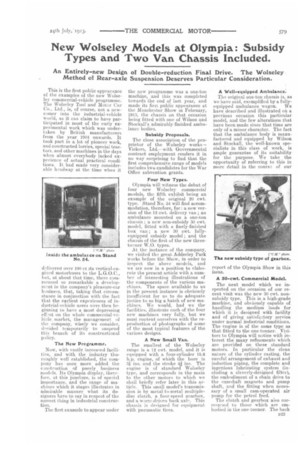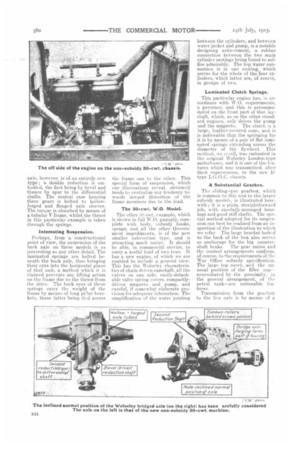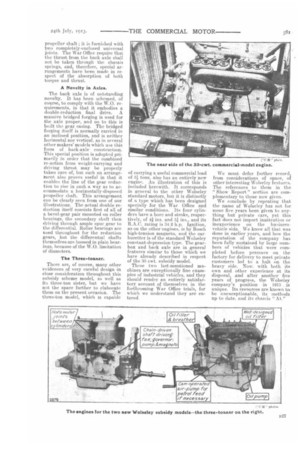New Wolseley Models at Olympia : Subsidy Types and Two Van Chassis Included.
Page 65

Page 66

Page 67

If you've noticed an error in this article please click here to report it so we can fix it.
An Entirely-new Design of Double-reduction Final Drive. The Wolseley Method of Rear-axle Suspension Deserves Particular Consideration.
This is the first public appearance of the, examples of the new Wolseley commercial-vehicle programme. The Wolseley Tool and Muter Car Co., Ltd., is, of course, not a newcomer into the industrial-vehicle world, as it can claim to have participated in most of the early experimental work which was undertaken by British manufacturers from the year 1904 onwards. It took part in a lot of pioneer work, and constructed lorries, special tractors, and other machines in the days when almost everybody lacked experience of actual practical conditions. It had made very considerable headway at the time when t
delivered over 100 er its vertical-engined motorbuses to the L.G.O.C., lett, at about that time, there commenced so remarkable a development in the company's pleasure-car business, that, taking that circumstance in conjunction with the fact that the earliest experiences of industrial-vehicle users were then beginning to have a most depressing eirct on the whole commercial-yehiele. market, the management of the company, wisely we consider, di,cided temporarily to suspend this branch of its constructional policy.
The New Programme.
Now, with vastly increased facilities, and with the industry thoroughly well established, the company has once more added the ieinstraction of purely business models. its Olympia display, therefore, at this juncture, is of special importance, and the range of machines which it stages illustrates in admirable manner what its designers have to say in respect of tho correct thing in industrial construction.
The first example to appear under the new programme was a one-ton machine, and this was completed towards the end of last year, and made its first public appearance at the Manchester Show in February, 1913. the chassis on that occasion being fitted with one of Wilson and Stoekall's admirably-finished ambulance bodies.
Subsidy Proposals.
The close association of the proprietor of the Wolseley works— Vickers, Ltd.—with Governmental contract employment renders it in no way surprising to find that the first comprehensive range of models includes two candidates for the War Office subvention grants.
Four New Types.
Olympia will witness the debut of four new Wolseley commercial models, the fifth exhibit being an example of the original 20 cwt. type. Stand No. 51 will find accommodation, therefore, for : a new version of the 12 cwt. delivery van ; an ambulance mounted on a one-ton chassis ; a new non-subsidy 30 cwt. model, fitted with a finely-finished box van ; a new :30 cwt. fullyequipped subsidy model ; and the chassis of the first of the new threetonner W.O. types.
At the instance of the company, we visited the great Adderley Park works before the Show, in order to inspect the above models, and we are now in a position to elaborate the present article with a number of interesting illustrations of the components of the various machines. The space available to us in the present instance is obviously insufficient for U8 to do adequate justice to so big a hatch of new machines. We would, had we the facilities, illustrate each of the four new machines very fully, but we must content ourselves with the reproduction of photographs of some of the most typical features of the various designs.
A New Small Van.
The smallest of the Wolseley range is a. 12 cwt. model, and it is equipped with a four-cylinder 15.6 h.p. engine, of which the bore is 3Ains, and the stroke aa ins. The engine is of standard Wolseley type, and corresponds in the main to the other motors to which we shall briefly refer later in this article. This small model's transmission is by metal-to-metal multipledisc clutch, a four-speed gearbox, and a worre-driven back axle. This chassis is designed for equipment with pneumatic tires.
A Well-equipped Ambulance: The original one-ton chassis is, as We have said, exemplified by a fullyequipped ambulance wagon. We have described and illustrated oh a previous occasion this particular model, and the few alterations that have been made since that time are only of a minor character. The fact that the ambulance body is nianufactored and equipped by Wilson and Stockall, the well-known specialists in this class of work, is ample guarantee of its suitability for the purpose. We take the opportunity of referring to this in more detail in the course of our report of the Olympia Show in this issue.
A 50-cwt. Commercial Model.
The next model which we inspected on the occasion of our recent visit was the new 30 cwt. nonsubsidy type. This is a high-grade machine, and obviously capable of handling the medium loads for which it is designed with facility and of giving satisfactory service under normal industrial conditions. The engine is of the same type as that fitted to the one-tormen Visitors to Olympia will notice with interest the many refinements which are provided on these standard motors. In particular the clean nature of the cylinder casting, the careful arrangement of exhaust arid induction piping, the complete and ingenious lubricating system (including a cleverly-designed filter), the embodiment of a chain drive to the camshaft magneto and pump shaft, and the fitting when necessaay of a small carn-operated air pump for the petrol feed.
The clutch and gearbox aiso cosvesperal to those which are embodied in the one-tonner. The back V.23 axle, however, is of an entirely new type ; a double reduction is embodied, the first being by bevel and thence by spur to the differential shafts. The central case housing these gears is bolted to hollowforged and flanged axle sleeves. The torque is absorbed by means of a tubular V frame, whilst the thrust in this particular example is taken through the springs.
Interesting Suspension, Perhaps, from a constructional pointof view, the suspension of the back axle on these models is as interesting as any other detail. The laminated springs are bolted beneath the back axle, thus bringing their eyes into the horizontal plane of that unit, a method which it is claimed prevents any lifting action on the frame due to the thrust from the drive. The back eyes of these springs carry the weight of the frame by means of long pillar brackets, these latter being tied across the frame one to the other. This special form of suspension, which our illustrations reveal, obviously tends to neutralize any tendency towards inward distortion of the frame members due to the load.
The 50-cwt. W.O. Model.
The other 30 cwt. example, which is shown in full W.O. panoply, complete with body, subsidy hooks, sprags, and all the other Government impedimenta, is of the new smaller subvention type, and is attracting much notice. It should be able, in commercial service, to carry a useful load of two tone. It has a new engine, of which we are enabled to include a general view. This has the Wolseley characteristics of chain-driven camshaft, all the valves on one side, easily-detachable valve spring covers, compactlydriven magneto and pump, and careful, if somewhat elaborate provision for adequate lubrication, The simplification of the water jointing between the cylinders, and between water-jacket and pump, is a notable designing achievement, a rubber connection between the two main cylinder castings being found to suffice admirably. The top water connection is in one casting, which serves for the whole of the four cylinders, which latter are, of course, in groups of two.
Laminated Clutch Springs.
This particular engine has, is] accordance with W.O. requirements, a governor, and this is accommodated on the front part of that layshaft, which, as on the other standard engines, only drives the pump and the magneto. The clutch is a large, leather-covered cone, and is is noticeable that the springing for it is by means of a pan. of flat laminated springs extending across the diameter of the flywheel. This method, we recall, was embodied in the original Wolseley London-type motorbuses, and it is one of the features which was transmitted, after their supersession, to the new type L.G.O.C.
A Substantial Gearbox.
The sliding-spur gearbox, which is common to this and to the larger tillbsidy Models, is illustrated herewith ; it is a plain, straightforward job, with carefully-arranged bearings and good etiff shafts. The special method adopted for its suspension can best be realized from an inspection of the illustration to which we refer. The large bracket bolted to the back of the box also serves as anchorage for the big countershaft brake. The gear ratios and the control arrangements conform. of course, to the requirements of the War Office subsidy specification. The large top cover, and the unusual position of the filler capnecessitated by the proximity, in the general arrangement, of thpetrol tank—are noticeable features.
Transmission from the gearbox to the live axle ie by means, of a propeller shaft ; it is furnished with two completely-enclosed universal. joints. The War Office require that the thrust from the back axle shall not be taken through the chassis springs, and, therefore, special arrangements have been made in respect of the absorption of both torque and thrust.
A Novelty in Axles.
The back axle is of outstanding novelty. It has been schemed, of course, to comply with the W.O. requirements, in that it embodies a double-reduction final drive. A massive bridged forging is used for the axle proper, and on to this is built the gear casing. The bridged forging itself is normally carried in an inclined position, and is neither horizontal nor vertical, as in several other makers' models which use this form of back-axle. construction. This special position is adopted primarily in order that the combined re-action from weight-carrying and driving thrust may be properly taken care of, but such an arrangement also proves useful in that it enables the line of the gear reduction to rise in such a way as to accommodate a horizontally-disposed propeller shaft. This arrangement can be clearly seen from one of our illustrations. The actual double reduction itself consists first of all of a bevel-gear pair mounted on roller bearings, the secondary shaft then driving through ample spur gear to the differentiaL Roller bearings are Used throughout for the reduction gears, but the differential shafts themselves are housed in plain bearings, because of the W,O. limitation of diameters.
The Three-tonner.
There are, of course, many other evidences of very careful design in close consideration throughout this subsidy scheme model, as well as its three-ton sister, but we have not the space further to elaborate them on the present occasion. The three-ton model, which is capable
of carrying a useful commercial load of 31 tons, also has an entirely new engine. An illustration of this is included herewith. It corresponds in general to the other Wolseley standard motors, but it is distinctly of a type which has been designed specially for the War Office and similar conditions. Its four cylinders have a bore and stroke, respectively, of 41 ins. and Eli ins., and its R.A.C. rating is 34.2 h.p. Ignition, as on the other engines, is by Bosch high-tension magneto, and the carburetter is of the standard Wolseley constant-depression type. The gearbox and back axle are in general features similar to those which we have already described in respect of the 20 cwt. subsidy model.
These two last-mentioned machines are exceptionally fine examples of industrial vehicles, and they should render an entirely satisfactory account of themselves in the forthcoming War Office trials, for which we understand they are entered.
We must defer further record, from considerations of space, of other interesting Wolseley features. The references to them in the " Show Report" section are complementary to those now given.
We conclude by repeating that the name of Wolseley has not for some five years been given to anything but private cars, yet this fact does not import inattention or inexperience on the businessvehicle side. We know all that was done in earlier years, and how the reputation of the company has been fully sustained by large numbers of vehicles that were completed before pressure on the factory for delivery to meet private customers led to a halt on the heavy side. Now. with both its own and other experience at its disposal, and after another five years of progress, the Wolseley company's position in 1913 is unique. Its resources are known to. he unexceptionable, its methods up to date, and its chassis "Ai."








































































